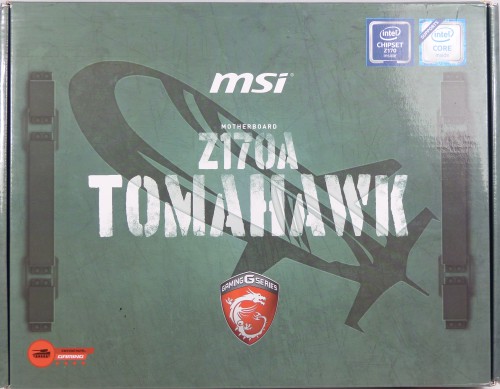Test – MSI Z170A Tomahawk | Specs | Price
Back at MSI today with a motherboard still equipped with the Z170 Express chipset from Intel, I named the Z170A Tomahawk! It’s not easy to find your way around the ranges of MSI motherboards as the names do not follow each other and have different names, Krait Gaming, Mortar, Tomahawk, XPower, Gaming Mx, well-lit whoever can give a clear and precise order of the upgrade of the various models.
Under this name of Z170A Tomahawk hides of course a motherboard with Intel 1151 socket compatible with the latest “Skylake” processors to date, in ATX format and multi-GPU compatible but only AMD with its Crossfire. Offered at a price of around 150 € it will have a lot to do to stand out from the competition, especially against the Gigabyte Z170X-UD3 tested previously which has many advantages,
| MSI Z170A Tomahawk | |
|---|---|
| Format | ATX (30.5cm x 24.4cm) |
| Socket | Intel LGA 1151 |
| CPU | Intel Celeron / Pentium / Core i3 / Core i5 / Core i7 |
| Chipset | Intel Z170 Express |
| Memory | 4 x DDR4 2133 Mhz “Dual Channel” Support XMP Maximum of 64GB Up to 3600 MHz (OC) |
| Expansion slots | 1 x PCIe 3.0 16X (working in 16X) 1 x PCIe 3.0 16X (working in 4X) 3 x PCIe 3.0 1X (working in 1X) 2 x PCI 1 x M.2 Type M (PCIe x4 / Sata 6Gb, NVMe compatible) 1 x M.2 Type E (wifi module) |
| Multi-GPU | AMD CrossFire 2-Way |
| Audio Chipset | Realtek® ALC892 + high-end capacitor |
| Wired Network | 1 x Realtek RTL8111H Gigabit |
| Wireless network | No |
| Number of connectors for fans | 5 x 4-pin PWM |
| Storage | Intel Z170: 1 x M.2 Type M 6 x SATA 6Gb / s Support RAID 0/1/5/10 |
| Usb | Back panel: 2 x USB 3.1 Gen 2 2 x USB 3.1 Gen 1 2 x USB 2.0 / 1.1 Internal connectors: 2 x USB 3.0 1 x USB 2.0 |
| Video outputs | 1 x HDMI 1.4 1 x DVI-D |
| Price | 150 € |
The MSI Z170A Tomahawk is therefore a standard ATX motherboard equipped of course with the 2170 chipset from Intel and therefore compatible with overclocking “K” processors (6600K and 6700K in this case) but also all 1151 processors ( Celeron, Pentium, i3 to i7 ..). DDR4 memory is also part of the game with “Dual Channel” operation ranging from 2133 MHz to 3600 MHz (in overclocking mode), XMP support will allow easier configuration at the frequency and timings of the kits sold.
Regarding the expansion ports MSI offers 2 PCIe 3.0 16x ports, one operating at 16x and the other at 4x, it is therefore very strongly recommended to connect the graphics card to the one which operates at 16X (the most close to the processor), it is possible to make a 2-card Crossfire.
In addition to these PCIe 3.0 16X the card has 3 x PCIe 1x and 2 x PCI. By seeing these characteristics it is clear that the Tomahawk is an entry-level card and is not made for big muscular configurations.
At the level of the integrated components we find for the sound part a Realtek ALC892 chipset accompanied by high-end capacitors, this will allow to have a completely correct sound. The network part is provided by a chipset from Realtek also, the RTL8111H, obviously capable of supplying Gigabit.
On the storage side, we are also in the entry level here with 6 Sata 6Gb / s connectors managed by the Intel chipset and an M.2 connector compatible with PCie 4x, Sata 6 Gb / S or NVMe SSDs), nothing that does not sort of ordinary except that there is no possibility here to install Sata Express peripherals. Another M.2 port is also part of the game but reserved for installing a WiFi and Bluetooth module, the same one used on the brand’s Z170A Tomahawk AC card.
Offered at a price of around 150 € it is clear here that there will be everything a user will need, but without frills, once again it is far from being equipped with its competitor Z170X-UD3 from Gigabyte.
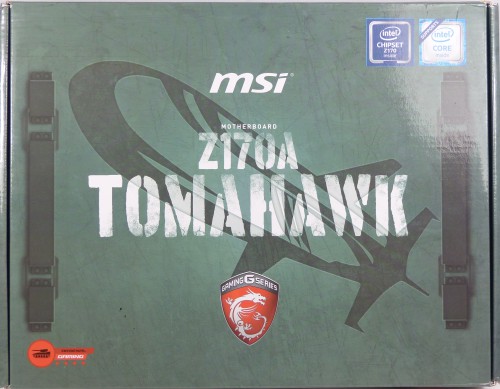
On the front of the box there is not much except the brand logo, the model as well as the “Gaming G Series” logo and the return of small stars to note the degree of gaming. the menu, two purely marketing elements that mean absolutely nothing between us.
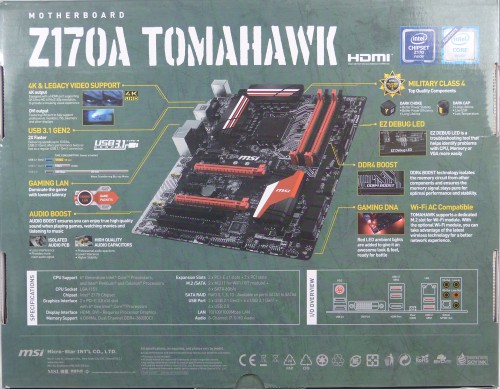
At the back a photo of the beast as well as a listing of its strengths. Two tables are also present, one for the technical characteristics and another showing the rear connectors.
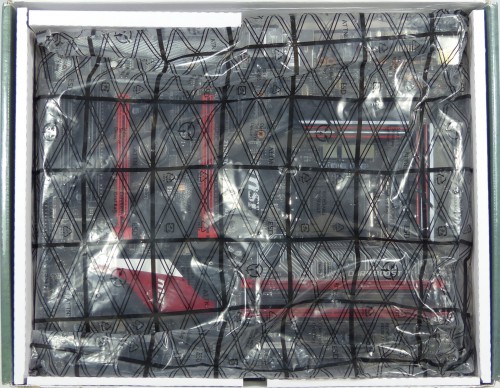
When opened, we fall directly on the motherboard packed in its antistatic bag.
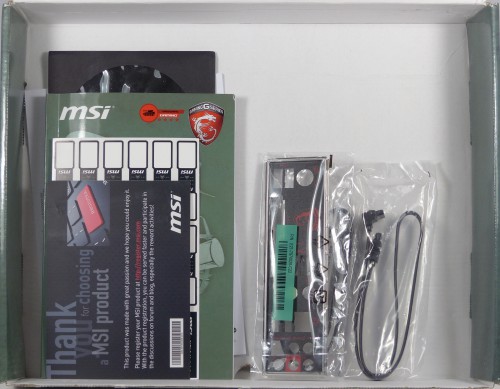
Below the card is the entire bundle.
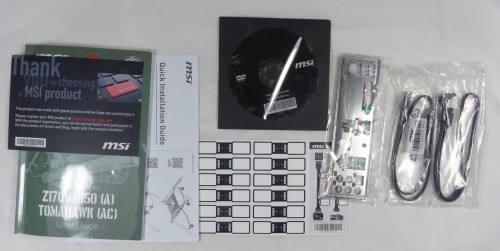
The bundle consists of:
- 1 x MSI Z170A Tomahawk motherboard
- 1 x manual
- 1 x quick installation guide
- 1 x driver DVD
- 1 x Label Plate for Sata Cables
- 1 x I / O plate
- 2 X Sata cables
As we can see the bundle of the card is rather classic, there is no frills here, only the essential! Only the label plate stands out a bit and will quickly find its way around if a lot of peripherals are installed.
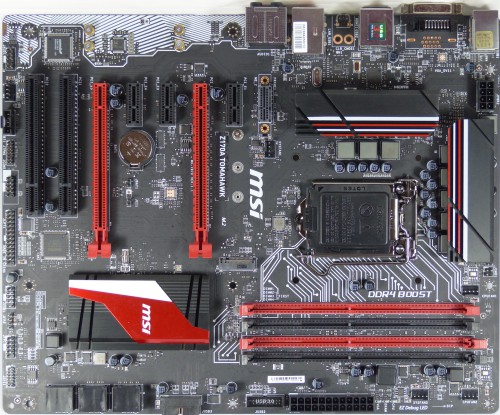
Here is the beast! We recognize here the “gaming” side of the card with this mixture of red and black so characteristic, not that it changes anything in the performance in games 😉 The build quality is very good, the components are of course not as numerous as on a high-end card and the whole can breathe well. Let’s take a closer look at all of this.
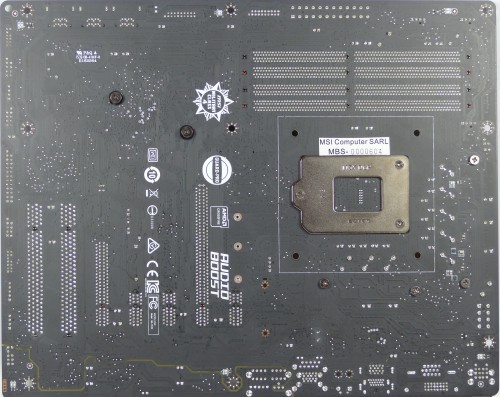
At the back we recognize the MSI tab with several logos, even if they will not logically be visible. Here, despite the entry-level orientation of the card, all the radiators are fixed using screws, which will ensure better contact of the radiators with the components and also better resistance over time, a good point! Once again the build quality is impeccable.
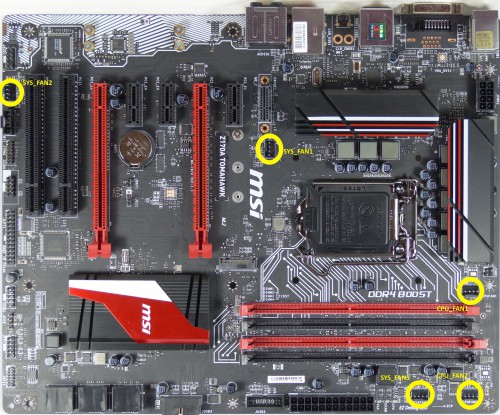
The MSI Z170A Tomahawk has 5 4-pin PWM connectors for fans, placed so as to be as close as possible to the case and processor fans, this should be sufficient for almost all configurations on the market.

MSI has made an effort on the sound part by adding high-end Nippon chemicon capacitors to the Realtek chipset, there are however not as many as on a high-end motherboard but this should suffice for a large majority of users.
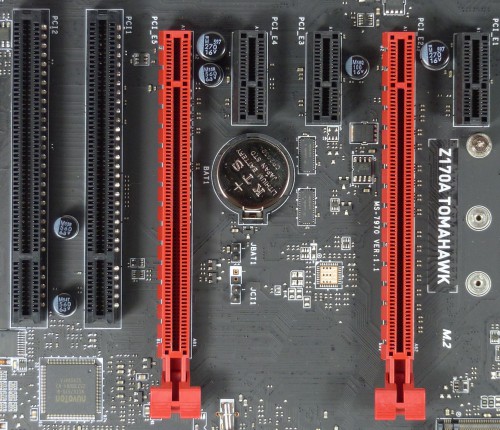
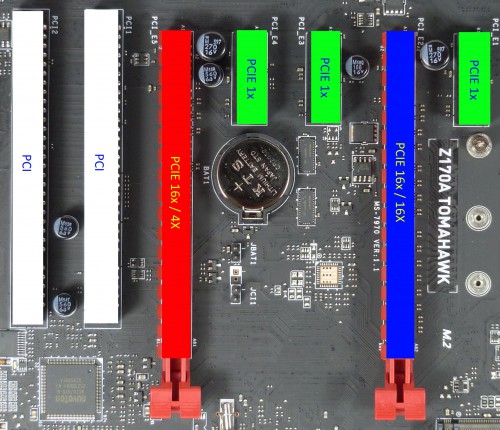
As I said above the card is equipped with a single 16x PCIe connector wired in 16x (the blue), the other is wired in 4x (the red), so it will be important to install the graphics card on the 16x to take full advantage of the installed graphics card. There are also 3 PCIe 1x ports and more strangely 2 PCI ports, the latter being doomed to disappear (and have disappeared on many cards) but can still be of some use for people with a sound card for example, or a RAID card etc. To the right of the photo is the M.2 port which will gladly accommodate a small SSD.

On the edge there are 6 Sata 6Gb / s ports controlled by the Intel chipset as well as another USB 3.0 port (in addition to the one glued to the 24-pin), this will be sufficient for 99% of users. The addition of a second USB 3.0 connector will be a godsend for those who want to install in addition to the USB 3.0 ports on the front a USB 3.0 card reader, which is not that rare.
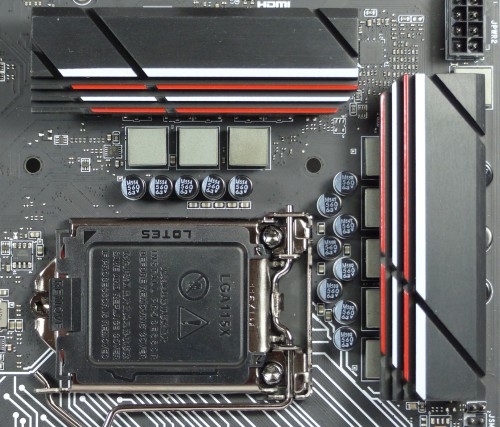
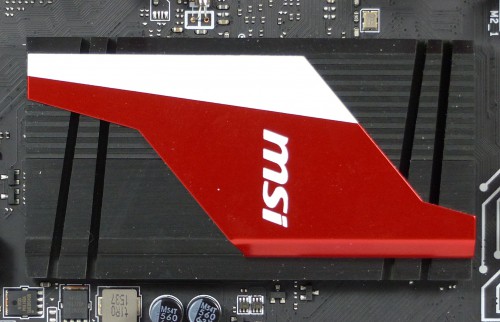
3 aluminum radiators are present on the board, this will be enough to properly cool the VRMs around the processor. Note that the small size of those placed around the processor will not hinder the installation of coolers, even the largest.

At the back we have the right to (from left to right):
- 1 x PS / 2 port and 2 x USB 2.0 / 1.1 port
- 1 x DVI-D port
- 2 x USB 3.1 Gen1 port, 1 x HDMI 1.4
- 1 x Clear CMOS button
- 1 x RJ-45 Gigabit, 2 x USB 3.1 Gen1
- 1 x sound panel
As we can see the number of connectors does not occupy all the available space, but with 6 USB ports including 4 x USB 3.1 Gen1, 2 video outputs as well as the eternal RJ45 Gigabit connector and 3.5mm jack and optical outputs for the sound should be sufficient for the vast majority of users. Adding a small Clear CMOS button will also be a plus for overclockers, no need to do it directly on the motherboard 🙂
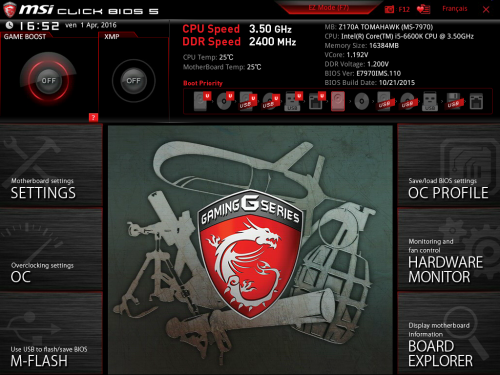
Here is the BIOS welcome screen, the “gaming” colors are once again out, red and black everywhere! The interface is pretty clean, the nails are on the left and right of the screen, hardware information is at the top of the screen. There are 2 buttons at the top left, 1 to activate / deactivate the XMP profile of the memory modules and another called “Gaming Boost”, like other motherboards this is only an automatic overclocking of the processor, the 6600K is here overclocked to 4.1 GHz at the push of a button.
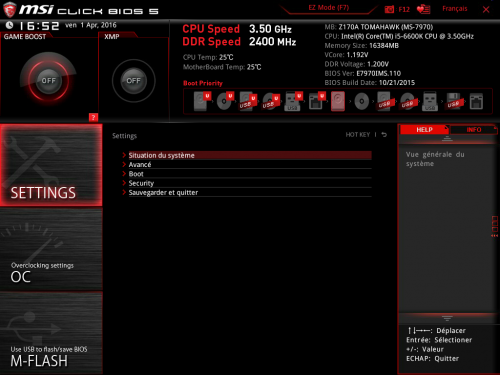
The “Settings” tab is split into several parts, which we will see right away:
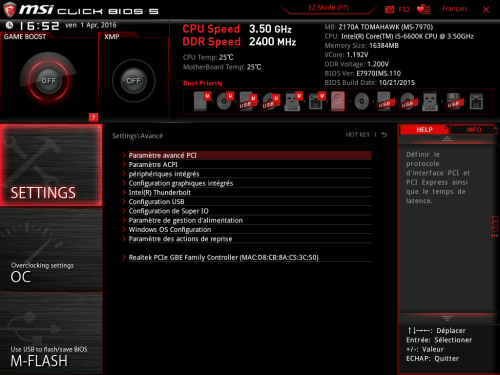
In “Advanced” as its name suggests, we have access to advanced BIOS settings, enable / disable onboard peripherals, enable / disable the GPU integrated into the processor, configuration of USB ports and so on.

The “Boot” tab of course allows you to manage the priority of the boot devices, and as much to say that the list is long!
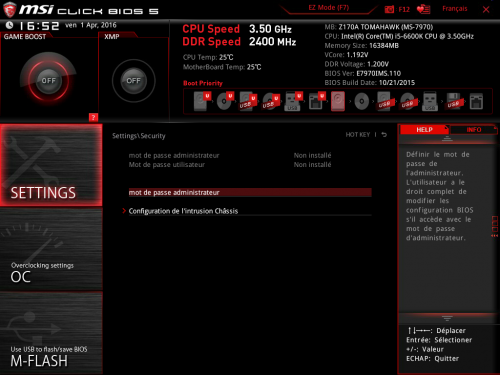
“Security” allows you to set a BIOS password in order to limit access and set up the chassis intrusion option.
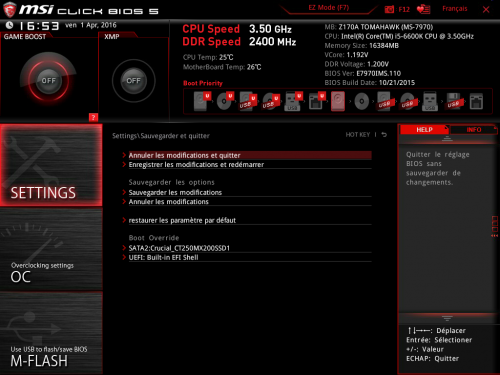
Finally, with the “Settings” tab, the “Save and exit” section allows you to save the settings, reset them as well as quickly change the priority of the devices at startup.
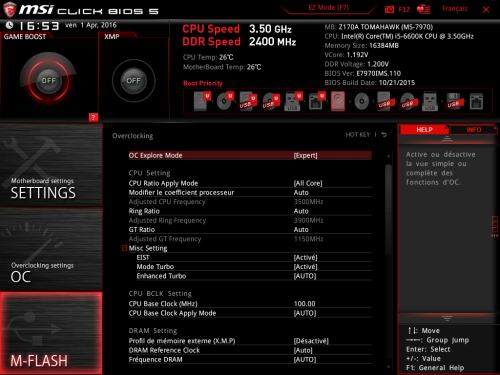
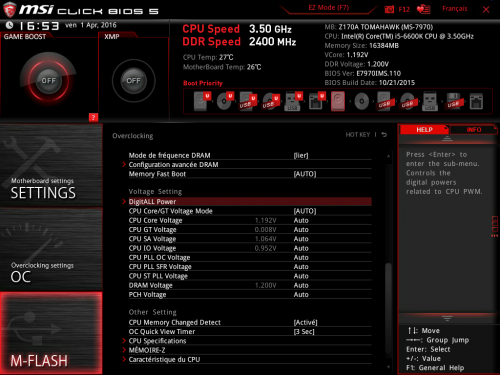
Now let’s move on to the “OC” tab, the sinews of war for some people, here MSI has provided its little one with everything you need, the first option “OC Explore mode” allows you to activate or deactivate the settings. advances. Voltages and frequencies can be changed whether for the CPU, memory or other internal components, fewer options than on more high-end cards but this will be more than more than enough !.
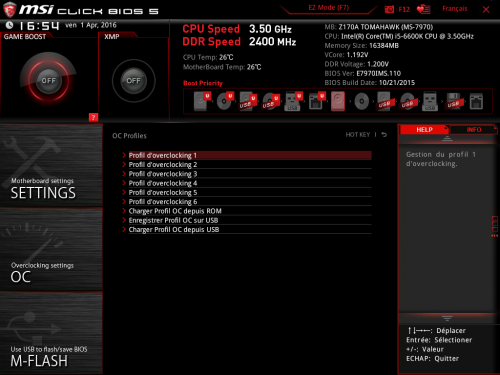
Now let’s go to the right tabs, the “OC Profile” part allows you to save and load profiles, it will be possible to do this either directly in the BIOS or on a USB key (in case a clear CMOS is necessary for example) .
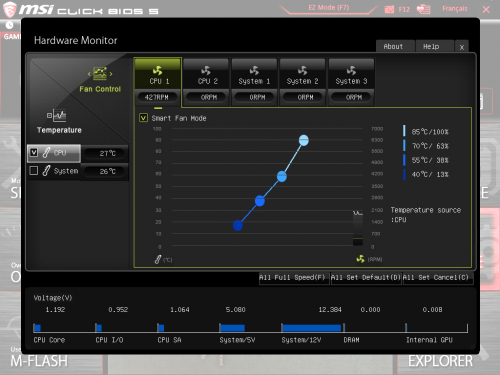
“Hardware monitor” is used to control the fans installed on the motherboard, the curve of the fans can be modified according to our wishes in relation to the temperature of the processor.
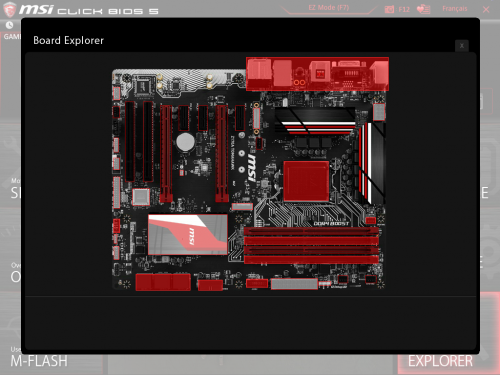
“Board Explorer” is a somewhat special tab, when you hover over the different parts of the board, explanations will be given, this can be interesting for beginners who do not know what the different components of the board correspond to.
The BIOS roundup is now complete! To summarize we can say that MSI offers a completely complete BIOS and which will be largely sufficient for all uses.
MSI offers us a motherboard with a fairly large panel of software available, without these being essential they can be useful if you want to overclock / adjust your fans / update your bios via Windows. I will take a quick tour of the main software available:
MSI Command Center

MSI Command Center is the software that will allow you to touch the frequencies and different voltages of the processor and memory, in other words overclocking! When launching, we fall directly on the “CPU” tab, various information is present, the current frequencies of the processor as well as a ventilation curve. Each parameter is configurable and modifiable on the fly.
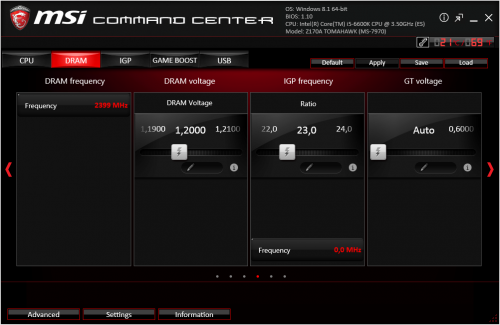
The “DRAM” and “IGP” tabs provide access to the various voltages, Memory and IGP, but very few settings are available.

“Game Boost” is also present here, in the same way as the BIOS it will be possible to overclock a Core i7 6700K to 4.4 GHz and a Core i5 to 4.1 GHz with a single click.
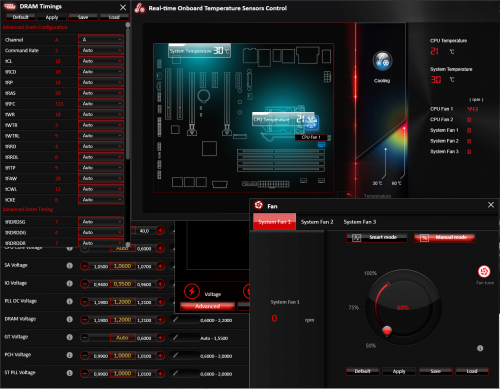
In “Advanced” much more precise settings are available, memory latencies, fan settings, processor voltages etc.
Intel Extreme Tuning Utility
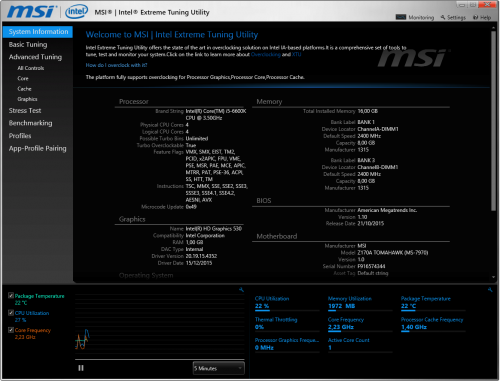
The software from Intel in partnership with MSI makes it possible to overclock the processor, voltages, frequencies, activate / deactivate the various features of turbo mode, etc. Benchmarks are also integrated in order to verify that the machine is quite stable.
MSI Gaming APP
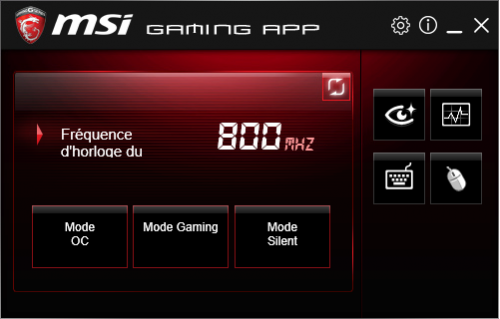
The MSI Gaming App utility allows you to manage the frequencies of the processor and the graphics card in 1 click, according to pre-recorded parameters. For example with “Gaming” mode the processor goes directly to 3900 MHz (even at rest) and the graphics card at its maximum operating frequency (if an MSI graphics card is installed) while the “Silent” mode returns the processor to its original idle frequencies (i.e. 800 MHz, but still 3900 MHz under load) and the graphics card at very slightly lower frequencies.
In addition to that several buttons are available on the right, here is:
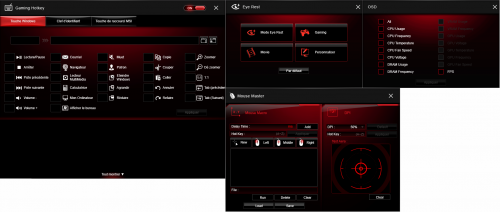
Several nice little tools here, it will be possible to do macros on the keyboard / mouse, and this with any model, which can be interesting. In addition to that an OSD is available and can display a lot of information on the screen during games (temperatures, frequencies, memory usage etc.) as well as modify the colors of the screen according to the type of use (brighter color during games, lower brightness with “EyeRest” mode, etc.).
MSI Gaming LAN Manager
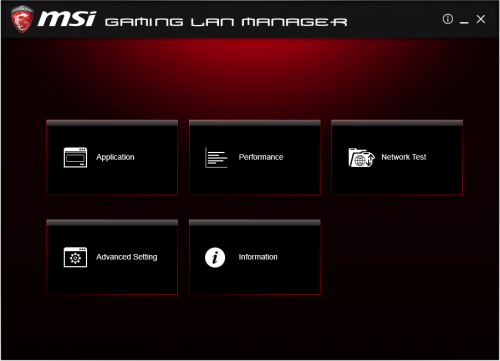
Under this very marketing name hides a software overlay allowing the prioritization of the packages, for example when a game is launched and a streaming video is played at the same time the software will make sure to give priority to the game rather than to the video in order to maintain an acceptable ping during the game. Quite honestly, the usefulness of this kind of utility is very limited, if the connection can’t keep up when a game is launched and different software is using the bandwidth then I would strongly advise cutting the unnecessary software.
The test platform
The MSI Z170A Tomahawk has been tested with the configuration below:
- Processor : Intel Core i5 6600K
- CPU Fan : Noctua NH-D15
- Memory : Corsair Vengeance LPX DDR4 2 x 4 GB 2666 MHz
- Hard Drive: WD Raptor 150 GB
- Graphics card : XFX 7870 Black edition
- Ventirad Graphics Card : Arctic Cooling Accelero S1
- Food : be quiet! E9 580CM
In order to have results covering a wide range of applications, I chose the following benchmarks:
- Cinebench R15 : downloadable here
- Handbrake : downloadable here
- 3DMark Fire Strike Physics : downloadable here
- SuperPI 32M : downloadable here
- Aida64 4.60 : downloadable here
- Bioshock Infinite and Shogun 2 Total war
- CrystalDiskMark : downloadable here
The card will be put in front of the other Z170 motherboards tested at Conseil Config namely the Gigabyte Z170X Gaming 7 (tested here), Gigabyte Z170X Gaming G1 (tested here), Gigabyte Z170X-UD3 (tested here), MSI Z170I Gaming Pro AC (tested here) and MSI Z170A XPower Titanium Edition (tested here).
Cinebench R15
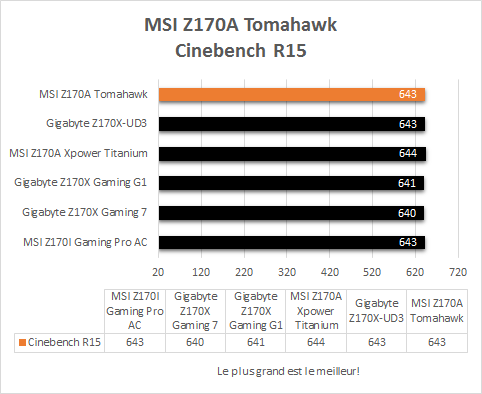
As usual the results are almost identical between all the cards, and this will continue throughout the tests. The Z170A Tomahawk with its 643 is at the same level as the other cards of the comparison, the differences are only anecdotal here.
Handbrake
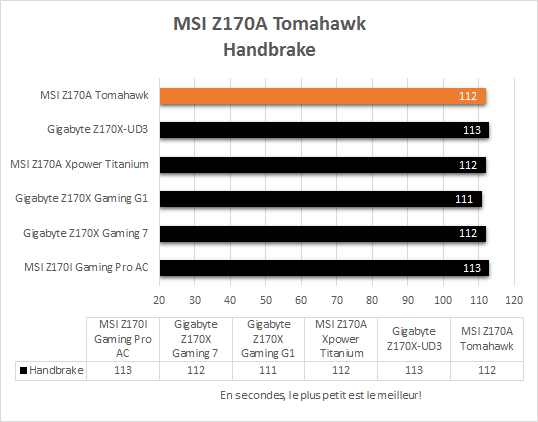
Under Handbrake and with the conversion of the 866 MB .avi file into .mp4, the results of all the cards fit in a pocket square, that is 2 seconds! Today’s MSI with its 112 seconds is placed in the middle of the pack.
SuperPI 32M

SuperPI 32M is not a game-changer here with 8 minutes and 16 seconds, again 2 seconds separate the fastest from the slowest, so again nothing of significant significance.
Aida64 5.3

The memory controller being integrated into the processor again the results are identical with all the cards, the beast is mainly there only to interconnect the different elements. The MSI Z170A Tomhawk once again performs very well with results reaching almost 37 Gb / s read to 49 Gb / s write and latency of 59.9 ns.
3DMark Fire strike and Games

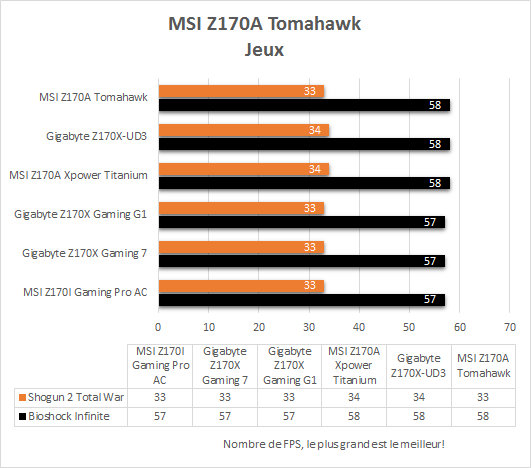
The games are once again not affected by the motherboard, under 3DMark Fire Strike (and more particularly its physics test) all the cards oscillate around 8800 while in the tests of the games the difference is only at the maximum of 1 FPS, nothing that cannot allow conclusions to be drawn except that there is no difference in “power” between the cards.
Sata CrystalDiskMark Debits
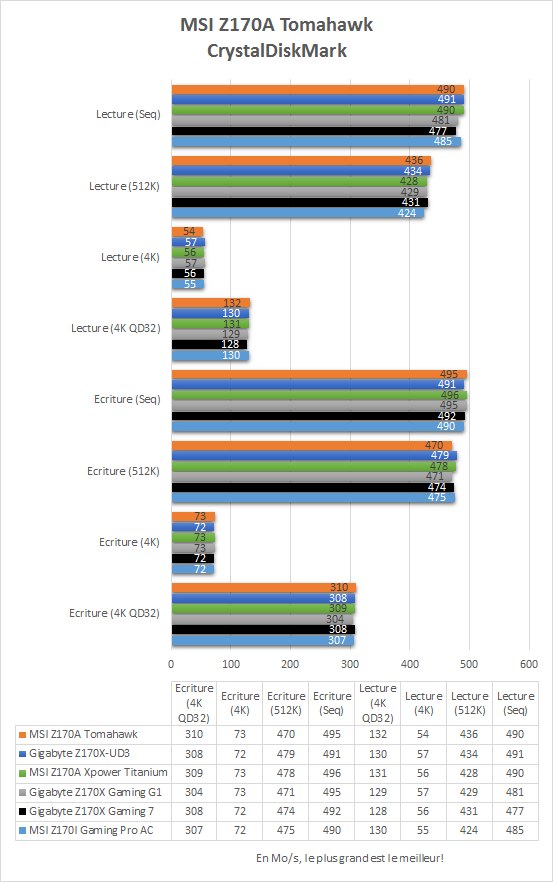
Nothing to report here, the speeds are identical between the 6 motherboards, nothing too surprising.
Ethernet speeds
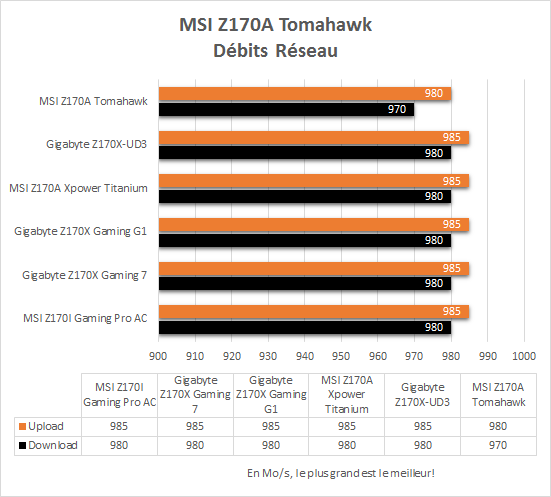
Taking into account the Realtek chipset instead of the Intel of the other cards, the MSI Z170A Tomahawk sees its maximum speed very slightly lower than the others, nothing serious however with a maximum of 980 Mb / s in upload for 970 Mb / s in download, this will clearly not restrict 99.9% of the population.
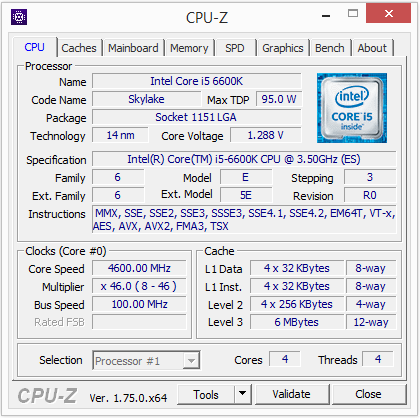
The Tomhawk Z170A does as well as all the other cards, blame it on the Core i5 6600K in my possession which can’t get over 4600 MHz without jitter. With 4600 MHz for 1.288V we are however facing a good overclock here and no instability has shown the tip of its nose, to see the limits of the card would require a processor capable of climbing higher.
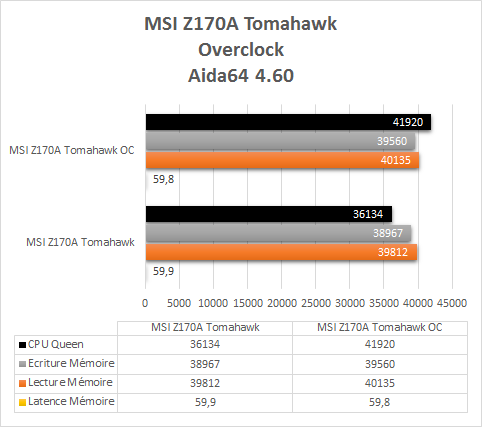

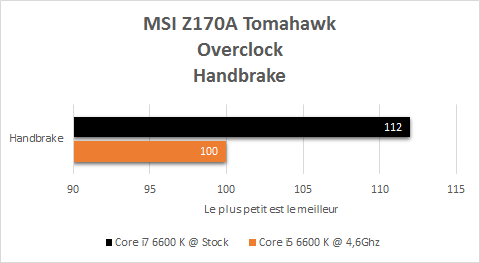
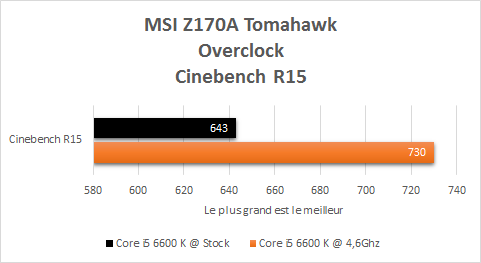
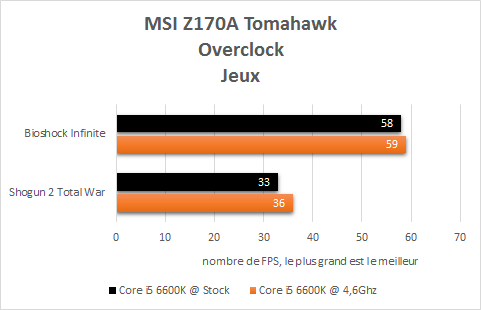
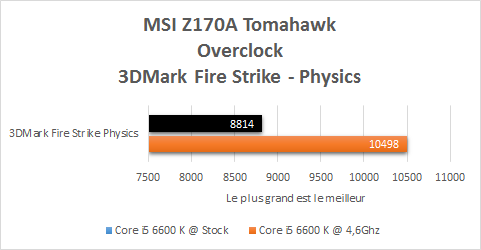
As one would expect the results reflect the rise in frequency perfectly, especially software using multicore in mass like Handbrake and Cinebench, it is clear that the encoding or the software of calculations will be in heaven. In games, however, the gain is marginal, as one might have suspected.
In the end, the MSI Z170A Tomahawk behaved very well and managed to contain the ardor of the Core i5 6600K overclocked to 4.6GHz (this will depend on the quality of the processor of course) while showing no signs of weakness or crashes during the hours of testing.
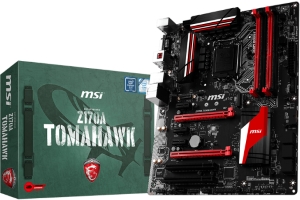
Here we are at the end of this test, what about the MSI Z170A Tomahawk?
MSI offers here a “gaming” motherboard equipped with a Z170 chipset particularly designed for the entry level, the manufacturing quality is excellent, the finishes also, the radiators are fixed using screws and not plastic clips this which reinforces the general quality of the thing.
When it comes to performance the Z170A Tomahawk clearly doesn’t have to be ashamed even against much more expensive motherboards, so there won’t be any hassle installing it in a gaming setup.
On the other hand the only small problem that I have to reproach him with does not come from itself but from the fierce competition that there is opposite, in particular the Gigabyte Z170X-UD3 which is offered at the same price but which offers more features, such as SLI / Crossfire compatibility (versus only the Crossfire on the Tomahawk), a higher-end Intel network chipset and some are more sophisticated.
Offered at a price of around 150 € the MSI Z170A Tomahawk is clearly not a bad card, it will fulfill its role perfectly while being stable and efficient, but for the same price you can find cards with more features.
Advantage
- Build quality
- Performances
- 2 internal USB 3.0 ports
- Look
Disadvantage
- Price / functionality ratio compared to the competition




